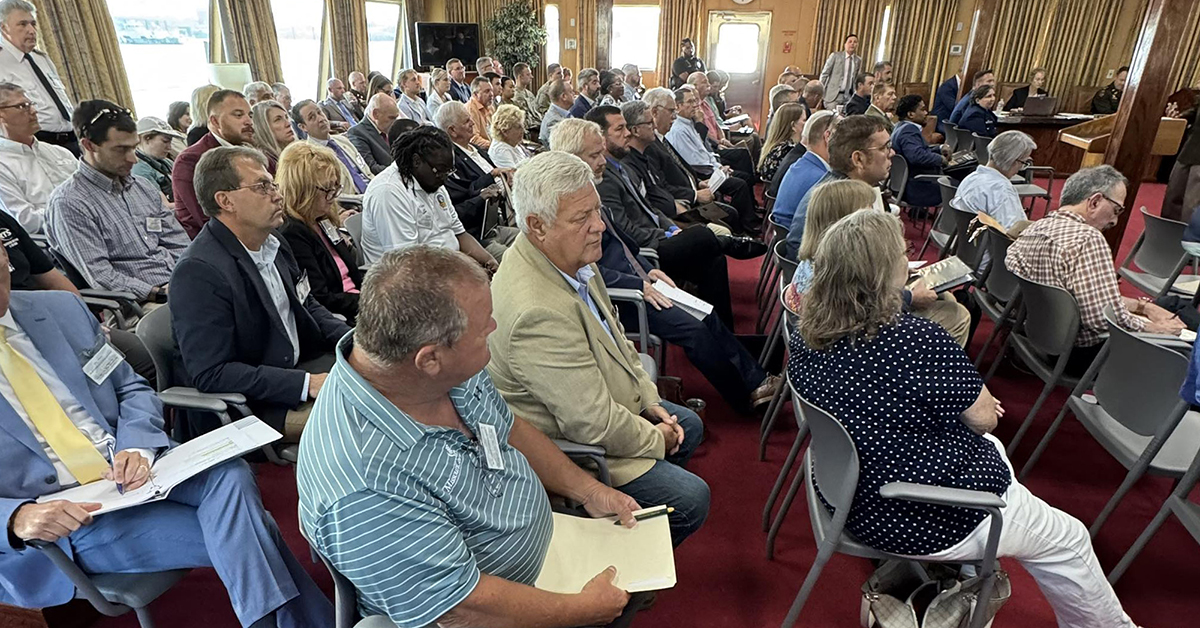The Mississippi River Commission (MRC) kicked off its annual low-water inspection tour on the St. Louis Riverfront August 15. It was the first of five public meetings scheduled to be held aboard the mv. Mississippi along the Lower Mississippi River. Subsequent meetings were scheduled for Caruthersville, Mo. (August 18); Memphis, Tenn. (August 19); Greenville, Miss. (August 20); and Morgan City, La. (August 22).
Maj. Gen. Kimberly Peeples, commander of the Mississippi Valley Division, presided over the St. Louis meeting. Peeples began her opening remarks by noting the Corps’ 250th anniversary. She briefly reviewed the history of the MRC and noted that three important districts—Memphis, St. Paul and New Orleans—all had new district commanders. Col. Daniel J. Herlihy, an MRC member who assumed command of the Great Lakes and Ohio River Division on August 13, was absent.
One of the oldest public advisory bodies in the country, the MRC was established by an Act of Congress on June 28, 1879. Congress charged it with the mission of developing plans to improve the condition of the Mississippi River, fostering navigation, promoting commerce and preventing destructive floods. During its annual tours, the MRC gives interested parties and members of the public a chance to offer public testimony about river-related issues. While flood control is a major mission of the MRC, all relevant water resource challenges are germane to flood control, said Lt. Col. Garrett Dean, secretary of the MRC. At the St. Louis meeting, most of the 31 speakers, who spoke in five-minute increments after submitting written statements, addressed levees and flood control.
St. Louis District Projects Reviewed
Col. Andy Pannier, commander of the St. Louis Engineer District, began by reviewing several major Corps projects in the area. The American Bottoms project involves 11 low-income communities in Illinois that have experienced repeated flooding. Studies in 1965 and 2007 highlighted problems with the levee system protecting the communities, and the Water Resources Development Act of 2024 authorized a re-evaluation. Pending funding, the Corps plans to develop between 4 and 6 alternate plans to address the ongoing issues.
Next, Pannier reviewed the Upper Mississippi Flood Risk and Resiliency Study. He noted that this study is different from the broader ongoing study of the Lower Mississippi, focusing more narrowly on flood control using a systems-based approach. The Upper Mississippi study is authorized by Congress but not yet funded.
Finally, he reviewed the progress of the Lock 25 expansion at Winfield, Mo., which is adding a modern 1,200-foot lock chamber to the existing 600-foot chamber, while allowing traffic to continue.
“We are basically turning a two-lane highway into a four-lane highway during active use,” Pannier said.
Outstanding challenges for the Corps in Pannier’s area of responsibility, he said, include finding suitable disposal areas for dredged material as existing disposal areas fill up and completing projects authorized by the Navigation and Ecosystem Sustainability Program (NESP) in a timely manner.
Coast Guard Cutter Fleet
Capt. Brandy Parker, sector commander of the U.S. Coast Guard at Sector Upper Mississippi, spoke on the urgent need to replenish the Coast Guard’s aging fleet of buoy tenders. Its five Aids to Navigation cutters are “increasingly unable to meet ongoing needs,” said Parker, who revealed that those cutters spent 2,600 out of 5,000 planned operating hours under repairs, often due to “engine casualties.” Unscheduled maintenance in a recent review period exceeded scheduled maintenance by 190 percent. New cutters are on order but years away.
“We won’t see a new cutter until at least 2030,” she said.
Sedimentation
Mike Morrow, mayor of Grafton, Ill., addressed sedimentation that is creating a problem for marinas in Grafton, a riverside town and tourist destination just north of St. Louis on the Illinois side that has bounced back from several devastating floods. Morrow attributed the problem to two dikes, located at Mile 219.5 and Mile 219.8. Morrow is an officer in the Mississippi River Cities and Towns Initiative (MRCTI), a grouping of mayors of communities along the length of the entire Mississippi River.
“We need more marshes and backwater areas along the entire length of the river for better flood control,” Morrow said.
He cited the partnership between MRCTI and Ducks Unlimited and noted that, while MRC itself does not make decisions, it can recommend projects in its reports to the president.
Morrow said that a set of memorial statues will be dedicated on the bluffs near Grafton next year. The National Memorial of Military Ascent will feature life-sized figures representing the assault on the Pointe du Hoc in Normandy, France, a key part of the invasion of Normandy during World War II.
Water export bill
Next up was Colin Wellenkamp, the founder of MRCTI who is now also an elected representative in the Missouri House representing the confluence district of St. Charles, Mo. His district, Wellenkamp said, has the largest number of “micro-basins” in the state and the second largest in the country after New Orleans. Wellenkamp mentioned two bills he authored or co-authored in Missouri’s House recently. One banned the export of Mississippi River water out of state. During the recent prolonged drought affecting large parts of the Midwest, there had been talk of using pipelines to export Mississippi River water to parched areas of the West.
The other bill expands the definition of “neighborhood improvement” to include disaster mitigation efforts to free up certain improvement funds for flood protection and other prevention measures, for example to create natural floodways and greenways.
Wellenkamp said the National Oceanic and Aeronautic Administration will unveil a new flood control dashboard in St. Paul on September 17.
Flow Frequency Study
Many of the speakers from levee districts and flood control associations referred to the Upper Mississippi River System Flow Frequency Study, an ongoing series of studies whose final release is scheduled for Fiscal Year 2028. The study is being conducted by the Corps of Engineers and is divided into three phases, with the first phase completed in 2022. The study is partially funded by Congress and includes developing a detailed scope of work, inventorying existing data and conducting a climate change assessment. A key component is the development of a Hydrologic Engineering Management Plan (HEMP) and a hydraulic routing model. The project includes multiple public reviews and study updates. A user-friendly, georeferenced, web-based product database will be developed to house the study’s results.
A number of speakers from levee districts and the Midwest Flood Control Association, though, urged the Corps not to release preliminary data from the studies until action plans have been developed to address flood control. They noted that the data the studies collect are supposed to inform those plans, but other federal agencies are using the preliminary data to make decisions—including decisions about flood insurance.
The other issue of greatest concern to levee districts was a change in the Corps’ policy toward dredged material. Up until a few years ago, the Corps gave dredged material to levee districts to use in building up their levees—which one levee district representative described as a “win-win.” In 2023, under Gen. Scott Spellmon, the Corps enacted policies to expand the beneficial uses of dredged material, including in levees. However, its cooperative agreements also began requiring public sponsors (usually levee districts) to indemnify the Corps against any damage occurring due to its use in construction projects. This meant increased costs—often substantial—for liability insurance.
————
Feature photo caption: The crowd gathered for the Mississippi River Commission’s August 15 meeting aboard the mv. Mississippi at the St. Louis Riverfront. (Photo courtesy of the Mississippi River Commission)




